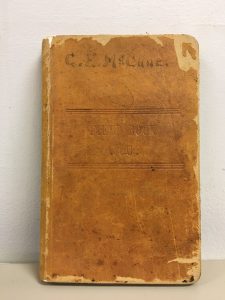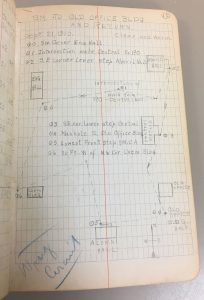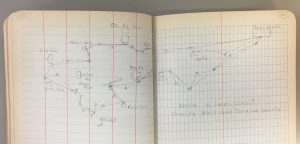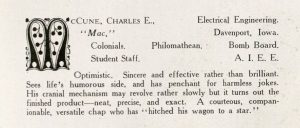“Sept. 7, 1910. Hot! C.E. McCune, Surveyor.”

These handwritten words, from page seven of a century-old Keuffel & Esser Co. Field Book 360, provide a small glimpse of one day in Ames, Iowa, according to Iowa State University 1911 electrical engineering graduate Charles E. McCune.

McCune’s 1910 notebook was found at a library book sale in Mentor, Ohio, and was purchased by Melissa Schaller, who has no ties to Iowa State and does not know how the notebook ended up at that library. Schaller mailed the book to the Iowa State College of Engineering, who passed the book on to the Department of Electrical and Computer Engineering, where it will be kept on display in Coover Hall.
“I initially looked for any family members that could be related to McCune but was not successful, so I thought this would be a great gift to Iowa State, where McCune’s engineering legacy began,” Schaller said. “I think Mr. McCune would appreciate the fact that his book was returned to his alma mater after over 100 years. I love his meticulous handwriting that has been preserved all of these years. You can tell he loved what he did.”
“What he did” appears to be surveying work on Iowa State’s campus, from September through December 1910, mapping distances between buildings by foot over the course of 63 pages in his notebook. The book never mentions the words “Iowa State,” but Schaller made the connection because of McCune’s hand-drawn maps showing Morrill Hall and the campanile.

It is unknown why McCune surveyed the campus — whether it was for a school assignment or project, a job he worked or a personal hobby — and the university has no recorded knowledge of his life after Iowa State. The Iowa Engineer‘s April 1911 issue lists McCune’s senior thesis project as “The Use of Electric Power on the Iowa Farm,” which he wrote with E.R. Martin, another student named in his surveying notebook with whom he took classes at ISU; but internet searches turn up nothing else on McCune. The surveying notebook is his legacy.
Page 15 of this notebook shows part of Iowa State’s campus, in a page titled “Level Circuit, Sea-Level B.M. [Benchmark] to Old Office Bldg and Return.” Here, McCune has drawn a map including Engineering Hall (now called Marston Hall), Morrill Hall, and other buildings on what is now the west side of campus. At the top of the page, he wrote, “Sept. 21, 1910. Clear and warm.” The map shows McCune’s measured paces from the southwest corner of Engineering Hall, to Morrill Hall, to Central Hall (now called Beardshear Hall), to the Office Building, to Alumni Hall (now called Enrollment Services Center), to the Chemical and Physical Laboratory and back to Engineering Hall. Of the buildings he names, all still stand except for the Office Building, which was razed in 2004, and the Laboratory, which burned in 1913.

On a second hand-drawn map later in the notebook, McCune expands across campus: “Nov. 23, 1910 (3 hrs) Cloudy and Cool.” He begins again at Engineering Hall, continuing on to Morrill Hall, Margaret Hall, Old Ag Hall (now called Carrie Chapman Catt Hall), Farm House, Power House, Sheep and Dairy Barns, Dairy Building (now called East Hall), New Ag Hall (now called Curtiss Hall), the campanile, Music Hall, Cranford Hall, Central Hall, Office Building and Chemical and Physical Laboratory, when he finally returns to Engineering Hall. Margaret Hall was a women’s dormitory, which burned in 1938, and Music Hall and Cranford Hall were located on the current grounds of the Memorial Union (MU); Music Hall burned in 1912, and Cranford Hall (part of the Sanitary Building) was destroyed when the MU was built in 1927. The barns were located near Farm House, which still stands today and has been restored to how it looked in 1910, the year McCune did his surveying.

Elsewhere in McCune’s notebook, he has a section titled “Height of Campanile with Transit,” where he writes, “Oct. 10, 1910 clear – warm.” According to his calculations on these pages, the campanile stands at 112.01 feet; however, the tower is 110 feet tall.
Iowa State’s campus saw a lot of growth during and just before the time McCune was a student: Engineering Hall (1903), Alumni Hall (1904-1907), the Dairy Building (1906), Beardshear Hall (1906), Curtiss Hall (1909) and the Engineering Annex (1910) were all constructed during this time. The campus terminal for the Dinkey train, which carried students to Ames’ downtown district as well as around campus, recently had been built near Morrill Hall, allowing for easier transportation.

The 1912 Iowa State College Catalog describes the campus this way: “The College occupies a delightful and healthful location upon high, rolling land in the west part of Ames, Story County. Situated at the junction of the north and south branch and the main double-track line of the Chicago & Northwestern Railroad, and connected with all the trunk lines of Iowa, Ames is easily accessible from all parts of the State. An electric railway connects Ames and the College with efficient service. The Fort Dodge, Des Moines and Southern Railway (electric), with stations on the campus, gives efficient service to the College… Ames is a most desirable town for wholesome college influences. Its people are thrifty, enterprising and cordial. The town has an excellent system of public schools, numerous churches, waterworks, and electric lights, and it also has a good city government. It is an inviting community for families who wish to educate their children and to enjoy a good environment at a reasonable expense.”
Another new venture at Iowa State took place during this time: The Department of Electrical Engineering was established in 1909, while McCune was a student; but classes in the field had been held since 1891. In 1907, Iowa State College President Albert B. Storms recommended to the State of Iowa Board of Trustees that a separate electrical engineering department be added, just in time for McCune to arrive on campus. In its first year, 176 undergraduate students were enrolled in the new department, which employed four instructors and staff members. However, surveying was not part of the electrical engineering curriculum, so the mystery of the notebook remains.

The ISU Special Collections and University Archives was able to locate McCune’s 1911 yearbook photo and a short description written about him in the book: “Optimistic. Sincere and effective, rather than brilliant. Sees life’s humorous side, and has penchant for harmless jokes. His cranial mechanism may revolve rather slowly but it turns out the finished product — neat, precise, and exact. A courteous, companionable, versatile chap who has ‘hitched his wagon to a star.'”
The yearbook notes that McCune was known as “Mac” from Davenport, Iowa, and that he was involved in a club known as the Colonials (“organized for the purpose of associating men who are interested, not only in scholarship and society, but also in literary and debating activity, athletics, and other phases of life at Iowa State College,” according to the 1911 yearbook); the Philomathean Literary Society, which met on Friday nights for speeches and debates and allowed members to stay out 30 minutes past campus curfew; the board of “The Bomb” yearbook, where he was responsible for the “literary and humerous” sections of the book; the staff of the student newspaper called Iowa State Student, now the Iowa State Daily; and the American Institute of Electrical Engineers, now the Institute of Electrical and Electronics Engineers, or IEEE.
While most of McCune’s life remains a mystery, this artifact provides a meticulous look at ISU in a time of growth, preserving important history of campus at the birth of electrical engineering at Iowa State.
“I love collecting old books, as they are an important part of our history that we need to locate and preserve for future generations,” Schaller said. “I love the feeling of holding a piece of history 100-plus years old. They are truly time machines into the past.”
